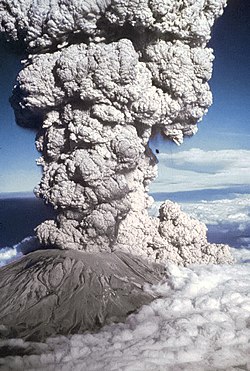
Back Vulkaan Afrikaans Vulkan ALS እሳተ ገሞራ Amharic Volcán AN Fȳrbeorg ANG Vọlikano ANN ज्वालामुखी ANP بركان Arabic بركان (جيولوجيا) ARY بركان ARZ


A volcano is a mountain that has lava (hot, liquid rock) coming out from a magma chamber under the ground, or did have in the past. Volcanoes[1] are formed by the movement of tectonic plates.
The Earth's crust has 17 major, rigid tectonic plates. These float on a hotter, softer layer in its mantle.[2] Volcanoes are often found where tectonic plates are coming together.
Volcanoes can also form where there is stretching and thinning of the crust's plates, e.g., in the East African Rift.[3] Volcanoes are usually not found where two tectonic plates slide past one another.
Volcanism away from plate boundaries is caused by mantle plumes. These so-called "hotspots", for example Hawaii, are thought to arise from upwelling magma from the core–mantle boundary, 3,000 km deep in the Earth.
Most volcanoes have a volcanic crater at the top. When a volcano is active, materials come out of it. The materials include lava, steam, gaseous sulfur compounds, ash and broken rock pieces.
When there is enough pressure, the volcano erupts. Some volcanic eruptions blow off the top of the volcano. Sometimes, the magma comes out quickly and sometimes it comes slowly. Some eruptions come out at a side instead of the top.
Volcanoes are found on planets other than Earth. An example is Olympus Mons on Mars.
Volcanologists are scientists who study volcanoes using methods from geology, chemistry, geography, mineralogy, physics and sociology.
The world's biggest volcano is named Mauna Loa in Hawaii. Mauna Loa is part of the five volcanoes on Hawaii's 'Big Island'. The most recent time this volcano erupted was in 1984. It erupted 33 times in the last 170 years. Like all the other Hawaiian volcanoes, Mauna Loa was created by the movement of the Pacific tectonic plate which moved over the Hawaii hotspot in the Earth's mantle. Mauna Loa is 4,196 meters tall. It is a shield volcano. The largest recent eruption from Mauna Loa left a lava trail 51 kilometres (32 miles) long.
- ↑ The plural of volcano can be either volcanos or volcanoes. Both are correct and it is not a matter of British vs US spelling. Oxford English Dictionary.
- ↑ NSTA Press / Archive.Org (2007). "Earthquakes, Volcanoes, and Tsunamis" (PDF). Resources for Environmental Literacy. Archived from the original (PDF) on September 13, 2012. Retrieved April 22, 2014.
- ↑ Foulger, Gillian R. (2010). Plates vs. Plumes: a geological controversy. Wiley-Blackwell. ISBN 978-1-4051-6148-0.